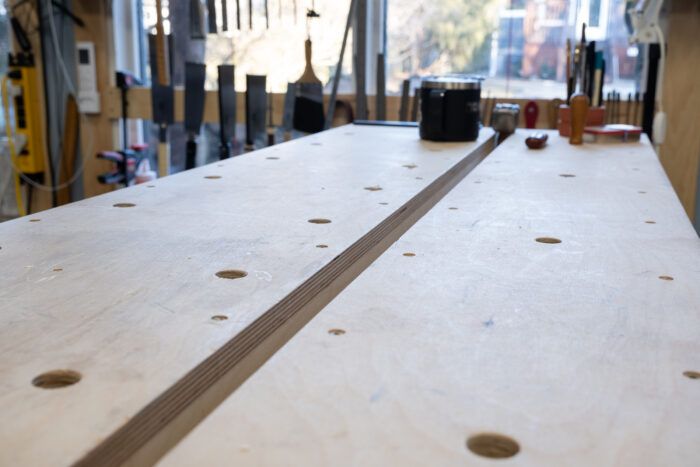Over the last few years there has been a lot of talk about workbenches. Many authors have written books on the subject concerning sizes, styles, and the materials they are made out of. To my mind, your workbench design should match the style of woodworking you like to do. Here’s how it’s broken down for me.
I like a smaller bench, no longer than 1500mm (60 in.) and no wider than around 550mm (22 in.). I find anything bigger leads to extra space that ends up being a collection point for junk and tools that don’t pertain to the task at hand. I like the height of the bench to come to my wrist joint, and for me that’s around 900mm (35-1/2 in.) for most tasks. I use a Moxon-style vise for joinery, which brings the work up a bit higher when sawing and doing chisel work.
There is no real rule of thumb regarding the construction of the bench, as long as it suits the way you work. That being said, a good workbench should be stout, free of racking, and heavy enough to stay put when you’re working on it. If you put your bench against a wall to work, then you don’t have to worry about it moving anywhere. There are many opinions about whether your bench should be against a wall or away from a wall to allow work on all sides. Again, this is up to you. I know many woodworkers and they seem to be evenly split as to what they like. One way is not necessarily better than the other.
There is also a lot of discussion about what the bench should be made out of. The first bench I built was the Michael Fortune design from The Workbench Book. It was made from solid maple with a rosewood tail vise and a Record front vise. It worked well enough, but for me the tail vise was a bit finicky and flattening the hard maple top was not a fun few hours. My next bench was a Nicholson-inspired bench that I feature in my first book, The Minimalist Woodworker. This one was made out of softwood (Eastern white pine) and I preferred it to my first bench. It was a dream to flatten and plenty stout for both hand and power tool use, though it could have been a bit heavier.
I am now on my third bench, and have learned from the first two. My current bench is essentially identical to the first Nicholson I made, but is made from laminations of Baltic-birch plywood. This version is dimensionally stable and weighs much more than its softwood twin. It has plenty of dog holes and a gap down the center for all sorts of workholding configurations, and it doesn’t have a vise since I enjoy using a Moxon-style one. In addition to being heavy, the plywood is replaceable. Going forward, this bench will not require any flattening since the top layer can be swapped out if the damage gets too great.
With time and experience, I have learned what I like and don’t like in a bench. We are fortunate that there is so much information out there on how to build one. This design works for me now, but you need to figure out what works for you. Take advantage of the information out there and research, be thoughtful, take your time, and plan out your first/next bench to suit you and the way you work. There is no one perfect bench for everyone, just the perfect one for you.








